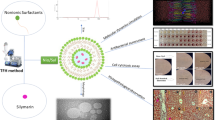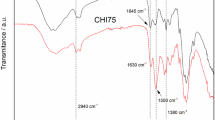Abstract
The therapeutic concentration of cisplatin (CDDP) is usually associated with dose-limiting side effects. To avoid these harmful effects, a biocompatible hydrogel carrier which consisted of poly(N-isopropylacrylamide) and carboxymethyl chitosan was designed to deliver CDDP to the local environment of a solid tumor. The poly(N-isopropylacrylamide)-g-carboxymethyl chitosan hydrogels were synthesized by chemical crosslinking. Scanning electronic microscopy images showed that the hydrogels exhibited a cross-linked structure with the average pore size from 100 to 200 µm. Water contact angles and swelling studies suggested that the hydrogels had good hydrophilicity and the lower critical solution temperature lay in the vicinity of 32 °C. The MTT assays implied that the hydrogels were non-cytotoxic on NIH3T3 cells. In vitro release experiment demonstrated that the release of CDDP was controllable and sustained over a long period. Moreover, the released CDDP retained its anticancer activity on A549 cells. The hydrogels are promising carriers for sustained release of cisplatin.









Similar content being viewed by others
References
Selvakumaran M, Pisarcik DA, Bao R, Yeung AT, Hamilton TC (2003) Enhanced cisplatin cytotoxicity by disturbing the nucleotide excision repair pathway in ovarian cancer cell lines. Cancer Res 63:1311–1316
Murata T, Haisa M, Uetsuka H et al (2004) Molecular mechanism of chemoresistance to cisplatin in ovarian cancer cell lines. Int J Mol Med 13:865–868
Hogberg T, Glimelius B, Nygren P, SBU-group (2001) Swedish council of technology assessment in health care, a systematic overview of chemotherapy effects in ovarian cancer. Acta Oncol 40:340–360
Hundahl SA (2002) Surgical quality in trials of adjuvant cancer therapy. J Surg Oncol 80:177–180
Yan X, Gemeinhart RA (2005) Cisplatin delivery from poly(acrylic acid-co-methylmethacrylate) microparticles. J Control Release 106:198–208
Yao X, Panichpisal K, Kurtzman N, Nugent K (2007) Cisplatin nephrotoxicity: a review. Am J Med Sci 334:115–124
Burger KN, Staffhorst RW, de Vijlder HC, Velinova MJ, Bomans PH, Frederik PM, de Kruijff B (2002) Nanocapsules: lipid-coated aggregates of cisplatin with high cytotoxicity. Nat Med 8:81–84
Kong Q, Kleinschmidt-DeMasters BK, Lillehei KO (1998) Intralesionally implanted cisplatin plus systemic carmustine for the treatment of brain tumor in rats. J Surg Oncol 69:76–82
Kopecek J, Kopeckova P, Minko T, Lu ZR, Peterson CM (2001) Water soluble polymers in tumor targeted delivery. J Control Release 74:147–158
Komane LL, Mukaya EH, Neuse EW, van Rensburg CE (2008) Macromolecular antiproliferative agents featuring dicarboxylato-chelated platinum. J Inorg Organomet Polym Mater 18:111–123
Withrow SJ, Liptak JM, Straw RC et al (2004) Biodegradable cisplatin polymer in limbsparing surgery for canine osteosarcoma. Ann Surg Oncol 11:705–713
Peng R, Qin G, Li X, Lv H, Qian Z, Yu L (2014) The PEG-PCL-PEG hydrogel as an implanted ophthalmic delivery system after glaucoma filtration surgery; a Pilot Study. Med Hypothesis Discov Innov Ophthalmol 3(1):3–8
Emoto S, Yamaguchi H, Kamei T et al (2014) Intraperitoneal administration of cisplatin via an in situ cross-linkable hyaluronic acid-based hydrogel for peritoneal dissemination of gastric cancer. Surg Today 44:919–926
Casolaro M, Cini R, Del Bello BD, Ferrali M, Maellar E (2009) Cisplatin/hydrogel complex in cancer therapy. Biomacromolecules 10:944–949
Oun R, Plumb J, Wheate N (2014) Cisplatin slow-release hydrogel drug delivery system based on a formulation of the macrocycle cucurbit[7]uril, gelatin and polyvinyl alcohol. J Inorg Biochem 134:100–105
Shen W, Luan J, Cao L, Sun J, Yu L, Ding J (2014) Thermogelling polymer-platinum(IV) conjugates for long-term delivery of cisplatin. Biomacromolecules 16:105–115
Zhang GQ, Zha LS, Zhou MH, Ma JH, Liang BR (2005) Preparation and characterization of pH- and temperature responsive semi interpenetrating polymer network hydrogels based on linear sodium alginate and crosslinked poly(N-isopropylacrylamide). J Appl Polym Sci 97:1931–1940
Chen YS, Tsou PC, Lo JM, Tsai HC, Wang YZ (2013) Poly(N-isopropylacrylamide) hydrogels with interpenetrating multiwalled carbon nanotubes for cell sheet engineering. Biomaterials 34:7328–7334
Wadajkar A, Koppolu B, Rahimi M, Nguyen KT (2009) Cytotoxic evaluation of N-isopropylacrylamide monomers and temperature-sensitive poly(N-isopropylacrylamide) nanoparticles. J Nanopart Res 11:1375–1382
Yoshizawa T, Shin-ya Y, Hong KJ, Kajiuchi T (2005) pH- and temperature-sensitive release behaviors from polyelectrolyte complex films composed of chitosan and PAOMA copolymer. Eur J Pharm Biopharm 59:307–313
Fang JY, Chen JP, Leu YL, Hu JW (2008) The delivery of platinum drugs from thermosensitive hydrogels containing different ratios of chitosan. Drug Deliv 15:235–243
Kim SY, Cho SM, Lee YM, Kim SJ (2000) Thermo- and pH-responsive behaviors of graft copolymer and blend based on chitosan and N-isopropylacrylamide. J Appl Polym Sci 78:1381–1391
Wang M, Fang Y, Hu D (2001) Preparation and properties of chitosan-poly(N-isopropylacrylamide) full-IPN hydrogels. React Funct Polym 48:215–221
Zhang L, Wang L, Guo BL, Ma PX (2014) Cytocompatible injectable carboxymethyl chitosan/N-isopropylacrylamide hydrogels for localized drug delivery. Carbohydr Polym 103:110–118
Lee JW, Jung MC, Park HD, Park KD, Ryu GH (2004) Synthesis and characterization of thermosensitive chitosan copolymer as a novel biomaterial. J Biomater Sci Polym Ed 15:1065–1079
Ritger PL, Peppas NA (1987) A simple equation for description of solute release II. Fickian and anomalous release from swellable devices. J Control Release 5:37–42
Appel EA, Forster RA, Rowland MJ, Scherman OA (2014) The control of cargo release from physically crosslinked hydrogels by crosslink dynamics. Biomaterials 35:9897–9903
Huang YH, Yu HQ, Xiao CB (2007) pH-sensitive cationic guar gum/poly (acrylic acid) polyelectrolyte hydrogels: swelling and in vitro drug release. Carbohydr Polym 69:774–783
ISO 10993-5 (2009) Geneva, Switzerland
Fan J, Chen J, Yang L, Lin H, Cao F (2009) Preparation of dual-sensitive graft copolymer hydrogel based on N-maleoyl-chitosan and poly(N-isopropylacrylamide) by electron beam radiation. Bull Mater 32:521–526
Yang G, Cao J, Li L, Rana RK, Zhu J (2013) Carboxymethyl chitosan-functionalized graphene for label-free electrochemical cytosensing. Carbon 51:124–133
Ye HF, Jin L, Hu RZ, Yi ZF, Li J, Wu YL, Xi XG, Wu ZR (2006) Poly(γ, l-glutamic acid)-cisplatin conjugate effectively inhibits human breast tumor xenografted in nude mice. Biomaterials 27:5958–5965
Xiao HH, Song HQ, Yang Q, Cai HD, Qi RG, Yan LS et al (2012) A prodrug strategy to deliver cisplatin(IV) and paclitaxel in nanomicelles to improve efficacy and tolerance. Biomaterials 33:6507–6519
Li XL, Li RT, Qian XP, Ding YT et al (2008) Superior antitumor efficiency of cisplatin-loaded nanoparticles by intratumoral delivery with decreased tumor metabolism rate. Eur J Pharm Biopharm 70:726–734
Gryparis EC, Hatziapostolou M, Papadimitriou E, Avgoustakis K (2007) Anticancer activity of cisplatin-loaded PLGA-mPEG nanoparticles on LNCaP prostate cancer cells. Eur J Pharm Biopharm 67:1–8
Lien YH, Wu TM, Wu JH, Liao JW (2011) Cytotoxicity and drug release behavior of PNIPAM grafted on silica-coated iron oxide nanoparticles. J Nanopart Res 13:5065–5075
Acknowledgments
This research was supported by National Natural Science Foundation of China (31370958) and Scientific Research Foundation in Fuzhou University (XRC-1249).
Author information
Authors and Affiliations
Corresponding authors
Additional information
Cui Cheng and Dandan Xia contributed equally to this work.
Rights and permissions
About this article
Cite this article
Cheng, C., Xia, D., Zhang, X. et al. Biocompatible poly(N-isopropylacrylamide)-g-carboxymethyl chitosan hydrogels as carriers for sustained release of cisplatin. J Mater Sci 50, 4914–4925 (2015). https://doi.org/10.1007/s10853-015-9036-7
Received:
Accepted:
Published:
Issue Date:
DOI: https://doi.org/10.1007/s10853-015-9036-7




